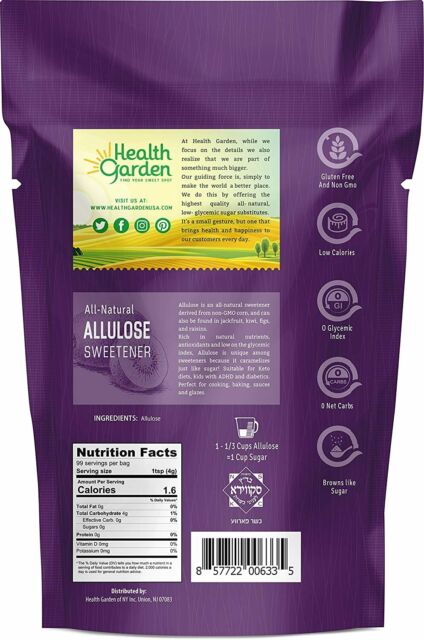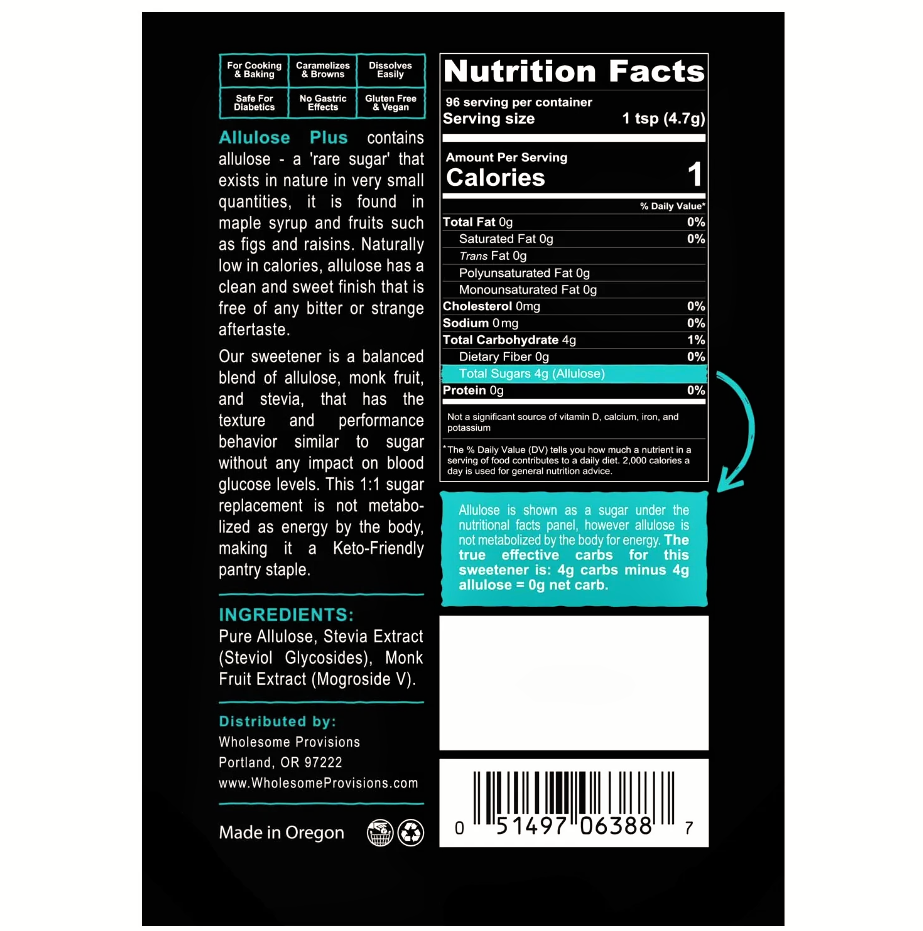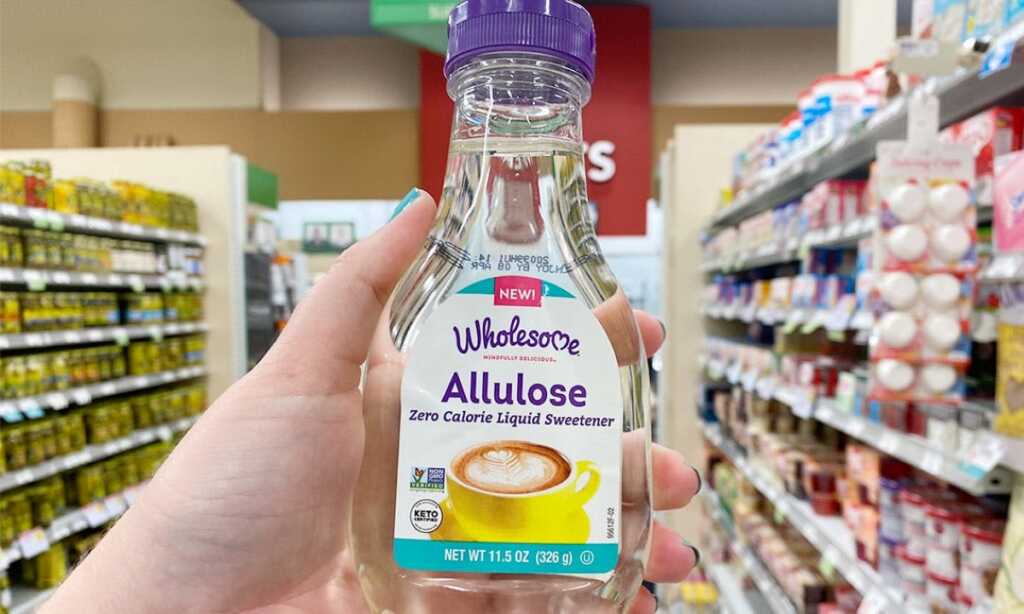Allulose is a type of ketohexose monosaccharide that naturally exists in very minute amounts in a variety of fruits, such as figs, dates, grapes, kiwis, and raisins. It also is found in minor amounts in a range of sweet foods such as caramel sauce, maple syrup, and brown sugar. Due to its tiny natural occurrences, allulose is referred to as a “rare sugar.” Recently, it has been discovered that allulose can be produced by fermenting sugar, just like we do to make kombucha. This became a game-changer. Enzymatic conversion of corn starch, beet sugar, or maize can produce the rare monosaccharide allulose. For increased production, it can also be produced from fructose and corn.
Other names for allulose include psicose, d-psicose, d-allulose, or pseudo-fructose. It has a calorific value of 0.4kcal/g, which is much less than the 4 calories per g in sugar and just 10% of the calories in sucralose. Allulose sweeteners are 70% as sweet as sucrose (sugar) and share their taste, texture, and other technical characteristics. It has almost no calories and has no effect on blood glucose levels therefore qualifies as a low-calorie sweetener.
Allulose Is a New Kind of Sugar That Doesn’t Count as Sugar
The United States Food and Drug Administration (FDA) has granted the status of “Generally Recognized as Safe” (GRAS) to allulose. According to the FDA People of all ages can enjoy it in foods and beverages.
An ingredient that is categorized chemically as “sugar” is permitted to be dropped from the Total or Added Sugars entries on Nutrition Facts labels by the U.S. Food and Drug Administration (FDA). According to a recent FDA announcement, allulose does not need to be included when calculating the “Total Sugars” or “Added Sugars” on Nutrition Facts labels. Still, it must be included in the grams of total carbohydrates.
In the US, Mexico, Columbia, Chile, Costa Rica, Japan, and Singapore, allulose is legalized and accessible.


Allulose Approval in Europe
To help the unique sugar reach the markets in Europe and the UK, ingredient companies have teamed up. Four ingredient companies have joined forces to form the Allulose Novel Food Consortium (ANFC), including the South Korean Sanyang Corporation, the Japanese Matsutani Chemical Industry, the European Cosun Beet Company, and the US-based Ingredion.
This novel, rare sugar is now going through the Novel Foods procedure to get regulatory approval in Europe. Does it possess the qualities that consumers seek in sweeteners? German researchers looked into whether this unique sugar has qualities that consumers would find appealing because EFSA (European Food Safety Authority) approval is “expected”. For this, the researchers analyzed consumer preferences for four sweeteners: erythritol, stevia, xylitol, and allulose. It comes in crystalline powder form and dissolves quickly in water. According to the experts, one of its key benefits is that it provides a “normal sugar flavor” and has similar functional properties as conventional sugar.
Why is Allulose Labeled Differently from other Sugars by the FDA?
The FDA came to the conclusion that allulose consumption had different health effects than most other forms of sugars based on its independent scientific studies. For instance:
- Tooth decay is not promoted
- There are 90% fewer calories in one gram of allulose than in carbohydrates like fructose and glucose
- Does not increase blood glucose or insulin levels
Compared to Other Sugars, How is it Different?
D-psicose is essentially a dietary fiber made from corn, not sugar. Rare sugar has a different molecular structure even though it shares the same basic components as fructose. This means that, unlike fructose (and other sugars), uncommon sugar is not processed by your body in the same way. The body doesn’t entirely digest it.
Allulose is actually processed by our bodies differently than other sugars. A molecule is unusual because of the way its bonds are structured. This makes it difficult for our body’s digestive enzymes to totally break it down and release the energy it contains.
Monk Fruit Sweetener
Monk fruit sugar is a more recent addition to the category of sugar substitutes. Mogrosides, a substance taken from the fruit, is around 250 times sweeter than regular sucrose, or table sugar, and contains no calories. However, monk fruit is obtained from the Luo Han Guo plant and allulose is found in some fruits such as figs, kiwi, and raisins.
Plant-based sweeteners are found in nature. Up until recently, only Stevia Extract and Monk Fruit were deemed suitable in this category of sweetener.
Allulose vs. Stevia and Monk Fruit: Plant-Based Natural Sweeteners
Stevia’s aftertaste is currently a problem. It was difficult to mix into drinks when it was originally introduced, and the fragrance was so overpowering that only strong coffee could be tolerated. These stevia leaves were unadulterated and pure. To improve its taste, manufacturers adopted a number of strategies. Monk fruit experiences similar issues having a strange or bitter aftertaste.
Researchers first noticed that allulose tastes just like sugar because it is commercially produced from sugar. Being a fermentation process, the extraction procedure is also advantageous. This sugar has a few drawbacks, including the fact that it is significantly more expensive than other sweeteners and challenging to source in large enough amounts for manufacture.

Positive Aspects of Allulose and its Health Benefits over Regular Sugar
- The most evident advantage of allulose is the reduction in calories, particularly from carbohydrates. Having only 5–10% of the calories of sugar for an equivalent sweetness means consuming fewer calories overall and maintaining a healthier nutritional balance.
- Allulose has a far superior insulin response than sugar, and even outperforms several other sugar substitutes. According to studies, not only it has a low glycemic index on its own, but it also slows down the digestion of other carbs with a high GI. This is ideal for people trying to combat blood sugar spikes and diabetes risk.
- Allulose would create far fewer gains in visceral fat than that of other sweeteners (erythritol and sucrose), making it even more advantageous for a diet that aims to reduce weight and body fat to prevent obesity. It’s a keto-friendly sweetener.
- Visceral fat that is found in organs, particularly the growth of a fatty liver, is also prevented from accumulating. When taken in place of sugar, allulose has been found to prevent the accumulation of liver fat, which is an important health advantage you might not have anticipated from a sweetener.
- Also, among the advantages is that it does not carry the same concerns of gastrointestinal discomfort as sugar alcohols. It is well-balanced because over 70-80% of it is either absorbed (but not utilized) or simply non-fermenting within the digestive system.
Allulose has fewer negative effects than some other sweeteners. It goes without saying that intake should still be moderated because any substance taken in excess is likely to cause discomfort.

Possible Side Effects
How much allulose should you eat? It has no official recommended daily dosage, however one study on gastrointestinal tolerance found that consuming 0.4 grams per kilogram of body weight at a time, or 0.9 grams per kilogram per day, would be safe. For a 70-kilogram person, this equates to 28 grams all at once or 63 grams every day.
Some people who consume more than this may get diarrhea and abdominal pain, although this side effect is not dangerous and is typically brief. Personal tolerance levels may differ. Other negative effects associated with taking allulose in increasing doses include bloating and decreased appetite.
Laying groundwork for mainstream market use of rare sugars
Allulose, as expected, differs significantly from the glut of sugar substitutes that have flooded the market in recent years, including erythritol, monk-fruit extract, and stevia.
The Virginia-based business Bonumose is investing in production and R&D and has a patented method that could allow the mass market adoption of rear sugars like allulose and tagatose. An innovative strategy is being utilized by Bonumose to prepare for the debut of the rare sugar tagatose in 2022. According to them, there is evidence that tagatose functions as a prebiotic, causing the production of the short-chain fatty acid butyrate and promoting the growth of beneficial bacteria in the large intestine. Bonumose has submitted a citizen’s petition urging the FDA to classify tagatose as dietary fiber.
Bonumose, which is presently concentrating on allulose and tagatose, revealed in a response to the FDA about rare sugar labeling that its unique technique also has the capacity to generate rare sugars that are not yet commercially available, such as D-allose, D-altrose, D-gulose, D-idose, and D-talose.
References
Samples, S. (2019). FDA Exempts Allulose from Added Sugar Labeling Requirements. [online] Allulose. Available at: https://allulose.org/fda-exempts-allulose-from-added-sugar-labeling-requirements/
foodnavigator.com (2022). Will novel rare sugar allulose resonate with European consumers? [online] foodnavigator.com. Available at: https://www.foodnavigator.com/Article/2022/08/31/will-novel-rare-sugar-allulose-resonate-with-european-consumers
Health Garden USA. (2021). Allulose Sweetener – Health Garden USA. [online] Available at: https://www.healthgardenusa.com/product/allulose-sweetener-14oz/
Wholesome Provisions. Keto Sweetener – Allulose Plus, 1:1 Sugar Substitute, Zero Aftertaste, 1 lb. [online] Available at: https://wholesomeprovisions.com/collections/the-peoples-keto-company/products/the-peoples-keto-company-allulose-monk-fruit-stevia-keto-sweetwner


Allulose: The Newest popular Plant-based Sugar on the Market